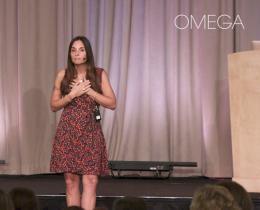Omega: In your early life you were an artist and concert violinist. What early spiritual lessons did you gather from your creative pursuits?
Jon: My mother really encouraged creativity. I remember she would get these large rolls of blank paper from the butcher. She would put them in my room and I’d have paints and everything else, and I would just draw and create. I had this freedom to express and to explore.
I remember hearing a violinist play when I was four, and I was so impressed. I told my mother that I wanted to play violin. She found a violin teacher in the area who said he would start me when I was six years old. Even at a very young age of six, I had this discipline. I focused on practicing every day. From age six to 20, I probably practiced two to four hours a day.
I eventually had a spiritual awakening when I was about 16. When I became a monk later, it felt like this natural resonance with discipline. I had this tenacious spirit.
I see that all the time with people today. I'm very familiar with it. I had to eventually learn to let go of all that personal will. There was a kind of entrainment in being a monk—doing all that meditation and following the schedule. It was very natural and very comfortable for me.
I was excited to get up at 3:00 a.m. in the monastery even though it was freezing and get to the meditation hall because I couldn't wait to find out what was going to happen in meditation. I always carried this kind of creative excitement in art, music, and in spirituality.
In the creative realm of art and music, you experience this whole other level where you transcend the form. You become very skilled at technique as a violinist, for instance, and then eventually you are improvising or you become the music. There’s no more "person playing a violin" anymore; there's just music happening. So these two worlds are similar in a lot of ways.
Omega: In 2002, you were formally asked to teach by Adyashanti. How did your friendship evolve and did he give you any advice for your teaching career?
Jon: We’ve been friends for a long time and we’re always sharing notes. When we first met, we had an immediate resonance in our backgrounds. We both grew up on the peninsula of the Bay Area, both into bicycling, and we had mutual friends in Sedona.
I had already had very deep relationships with a few teachers. Jean Klein was my first teacher. Then I was invited by Papaji, formerly known as Poonjaji, to come and see him. I spent about six weeks with him in India in 1991.
Adya used to call me “the reluctant teacher,” and when he first asked me about teaching, both of my parents were close to dying and I was very close to both of them and very involved in their care and managing everything that was going on in their life.
I remember he said to me, “Jon, you have more integrity than anybody I’ve ever met and for you not to be teaching would be nothing less than holding back.”
Years later, after both of my parents died, I had a retreat cabin out in Bolinas, which is north of San Francisco on the coast. I was spending a lot of time there. I had what I thought was the finances to do that. And then I had a rude awakening when I found out that all of my life savings and inheritance was lost in the Bernard Madoff scandal. All of a sudden, I had no money and I had very little income.
I had cut back on teaching and Adya called me the next day, he said, “Well Jon, it looks like you’re going to be forced to be doing what you're really meant to be doing.”
So yes, he has given me advice. He’s been a great friend and mentor and support. It’s been wonderful to have our friendship all these years.
Omega: Nonduality is a philosophical, spiritual, and scientific concept. How has it influenced your life and work?
Jon: To me, the term nonduality is a repackaging of ancient teachings. This is nothing new. People use that term in many, many ways. Just like they use the term enlightenment in many ways. I'm interested in removing terminology and getting intimate with direct experience of reality to the point that a separation between reality and one’s personal self dissolves.
That reality is what’s referred to as nonduality. It’s called presence or divine consciousness. It’s not a concept; it’s really a description of a profound shift in perception.
One of the things I’ve been teaching lately is the distinction between the description of awakened consciousness and instructions toward awakened consciousness. A lot of people confuse them and take spiritual platitudes and try to reverse engineer them.
They hear about someone who is supposedly enlightened and that they’re at peace and joy and oneness, and then people try to have those experiences, rather than try to really open into the mystery of not knowing and allowing how that natural unfoldment within them can actually occur.
From my perspective, awakening to the realm of nonduality where your personal self and your spiritual self are not separate is as natural as a seed germinating, sprouting, and becoming a flower. It’s just our nature. I think the hardest thing for the human ego to step away from is in being the doer of it.
“Teaching” is really this nonverbal experience of the unified field we call presence.
Omega: In your workshops, you help people learn how to relax. How have we lost this connection to a fundamental human state and how can we learn to calm down with so much happening around us?
Jon: The simplest answer is that we’re trying to get somewhere before we’re there, and that naturally creates stress on the nervous system.
When I left the monastery in 1979, I moved back to San Francisco and trained to be an Alexander Technique teacher and went into practice in 1981. Alexander and Zen are very similar.
Alexander discovered that people naturally contract their head back and down on their spine. He called it the startle pattern or the “fight-or-flight response” in response to stress. But people are permanently in a contracted state. So when you sit and you start meditating, you start becoming aware of all of these tensions that you have unconsciously developed throughout life to cope in the world.
It’s not easy for most people to stop and learn to be present. In fact, I remember when I was first a guest student at the Zen Center and one of my fellow guest students had been a Marine. He told me that sitting still for 40 minutes on the meditation cushion was harder than going through Marine boot camp.
I think learning to relax is really learning how to be here. It’s really a profound teaching, always will be. When we’re fully here, there’s no one who is here. That's the realm of the nondual. When we touch that within ourselves, we have, at least for that moment, an experience of being at peace. Once someone touches that and it's really their calling to follow it, they're going to be on the path.



